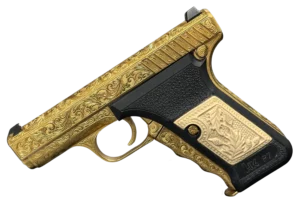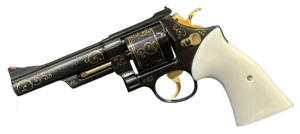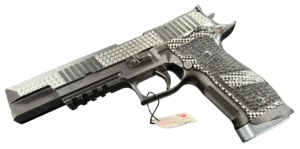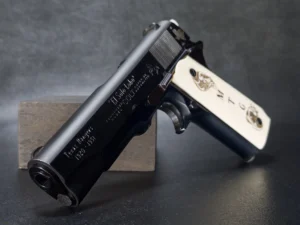Key Takeaways:
- FEGA isn’t just about technique — it’s about storytelling and community: At its core, the Firearms Engravers Guild of America is less of a rigid institution and more of a living, breathing network of artists. These are people who care deeply about turning steel and wood into narrative canvases. Whether it’s a scroll pattern passed down through generations or a bold new design etched by a first-timer, what matters most is the story behind the work — and the people who help shape it.
- Tradition and technology aren’t enemies — they’re collaborators: You might think an old-school art like hand engraving would be at odds with tech, but FEGA’s found a sweet spot. While many of its members still use chisels and hammers, others are bringing in digital design tools and laser precision. And guess what? That blend doesn’t water down the craft—it opens new doors, as long as the heart and artistry stay intact.
- FEGA’s future hinges on mentorship, openness, and staying human: In a world where machines can etch patterns in seconds and AI churns out designs in milliseconds, FEGA’s staying power lies in its human touch—literally and figuratively. By mentoring new talent, embracing diverse voices, and fostering genuine relationships with collectors and enthusiasts, the Guild isn’t just surviving; it is thriving. It’s evolving, without losing what made it special in the first place.
Back in the late 20th century, a small group of engravers decided they wanted more than just a trade—they wanted recognition not just among gun owners but in the broader art world. That shared vision gave rise to the Firearms Engravers Guild of America, also known as FEGA. What began as a humble gathering of passionate artisans has evolved into a respected organization with a global influence. More than just a guild, FEGA has become the heartbeat of American gun engraving, blending tradition with progress in ways that continue to surprise even the most seasoned collectors.
At its core, FEGA represents a significant shift. It helped transform engraving from something often seen as a decorative luxury into a form of expression that can stand shoulder to shoulder with sculpture, painting, and other fine arts. And make no mistake: this wasn’t just about recognition. It was about preserving something beautiful while opening the doors to new ideas, new tools, and a broader audience.
The Birth of a Movement
The early days of FEGA were electric with possibility. Founding members—some of whom were self-taught, while others were trained in old-world European styles—shared everything: ideas, failures, successes, and a relentless desire to elevate the craft. They didn’t just sit around carving scrolls into steel; they debated technique, critiqued each other’s work, and gradually built a standard that others would come to respect and emulate.
They weren’t aiming to create a museum. They wanted a living, breathing community where creativity could flourish. That’s precisely what happened. Over time, as the word spread, engravers from across the country—and eventually the world—joined in. Each brought their own voice to the conversation, and FEGA’s tapestry of styles became increasingly rich and varied.
More Than Just Decoration
One of the most significant changes FEGA has helped bring about is the way people view engraved firearms. There was a time when only the wealthy bothered with them—when ornate guns were locked away in velvet-lined cases, more showpiece than shooting iron.
But FEGA helped turn the tide. By pushing artistic boundaries and holding engravers to a higher bar, the guild reframed these firearms not just as collectibles but as genuine works of art. And this wasn’t just for show. Many of these guns are fully functional—masterpieces that work as hard as they wow.
FEGA also advocated for the kind of respect other art forms take for granted. Engraving isn’t just “nice lines on metal.” It involves design sense, deep technical skills, historical awareness, and a good dose of storytelling. And when done right, it turns a mechanical tool into something soulful.
Holding the Torch: Legacy and Future
FEGA’s legacy isn’t just written in scrollwork and gold inlays—it’s alive in the next generation of artists they help shape. The guild has taken mentorship seriously from the beginning, and that commitment continues today. By creating a platform where emerging talent can learn from seasoned professionals, FEGA ensures that the knowledge remains current and relevant over time. Instead, it evolves.
That blend of tradition and forward-thinking has helped the guild stay relevant. Rather than treating new technologies as threats, FEGA has welcomed tools like CAD and laser guidance as part of the engraver’s modern toolkit. The result? More detail, more consistency, and a chance to dream bigger.
You’ll still see classic, hand-cut scrollwork in FEGA’s ranks—but you’ll also find stylized wildlife, abstract designs, and even modern pop culture references. It’s a mix that feels less like a compromise and more like creative freedom.
Artists in Steel and Spirit
Now, let’s discuss the heart of the matter: the engravers themselves. These aren’t just technicians; they’re storytellers, historians, engineers, and designers rolled into one. Their canvas? Steel. Their tools? Tiny chisels, gravers, and a whole lot of patience.
Every FEGA master has walked a long path to get there. Most begin under the watchful eye of a mentor, learning how to hold a tool properly, how to read metal grain, and how to keep your lines clean. That apprenticeship isn’t just about skill—it’s about absorbing the culture of discipline, precision, and pride that defines the guild.
As these engravers develop their style, something magical happens. You start to see personality in the work—bold flourishes, quiet details, and themes that speak to the artist’s background or imagination. Some draw from nature. Others lean into classical ornament. And some? They blaze their own trail, borrowing from tattoo art, street graffiti, or Japanese woodcuts.
But there’s one thing they all share: an ability to harmonize with the firearm itself. Good engraving doesn’t just sit on a gun like a sticker. It flows with the contours, echoes the mechanics, and complements the purpose. It’s enhancement, not interruption.
Techniques: From Hammer and Chisel to Pixels
While hand engraving remains at the core of what FEGA stands for, it doesn’t exist in a vacuum. Technology has reshaped what’s possible—and how fast it can be achieved. But that doesn’t mean the romance of handwork is lost.
Gravers and chisels still have their place, especially in jobs that call for a human touch. However, FEGA engravers also utilize tools such as microscopes, pneumatic handpieces, and digital sketching pads. Some designs begin life on a screen, meticulously mapped out before a single cut is made. Others are done entirely by hand, eyeballed with decades of muscle memory.
Laser engraving, once feared as a “shortcut,” has found its place, too—especially in commercial or production settings. But among FEGA artists, it’s often just one more technique in the arsenal. The key isn’t the tool—it’s how it’s used. In the right hands, even a laser can feel personal.
Style-wise, FEGA artists continue to surprise. Some prefer Renaissance-inspired floral scrolls. Others lean toward modern minimalism. You’ll see mythical creatures, military tributes, Art Deco symmetry—even elements pulled from comic books or tribal patterns.
It’s this wide range that keeps FEGA’s exhibitions fresh and exciting. No two engravers think exactly alike, and it shows.
Beyond Borders: A Global Conversation
Though “American” is in the name, FEGA’s reach goes far beyond U.S. borders. Artists from Europe, Asia, and Latin America have found common ground with the guild. In return, FEGA has welcomed outside perspectives.
It’s not unusual to see a Swiss-style scroll next to a Japanese wave pattern or a Mexican Day of the Dead motif—all under one roof. This isn’t a dilution of tradition; it’s a celebration of global craft.
International collaborations have become increasingly common as well. Artists swap techniques, trade critiques, and even co-author pieces. And at major shows, it’s not just about displaying—it’s about exchanging. Ideas, tools, approaches. Everyone benefits.
FEGA’s commitment to openness and shared knowledge has turned it into more than a guild. It has become a kind of cultural ambassador, helping to bridge gaps between generations, styles, and even countries.
The Collector’s Eye: Why FEGA Matters to the Market
For collectors, a FEGA stamp on an engraved firearm isn’t just about aesthetics—it’s a mark of quality and pedigree. It tells a story of care, skill, and certified craftsmanship. And for some, it also means investment value.
FEGA-certified guns routinely fetch top dollar at auctions, especially when tied to well-known names in the guild. But even beyond market value, there’s something emotionally powerful about owning a gun that an artist poured their soul into.
Interestingly, FEGA’s influence has also shifted what collectors want. The market isn’t just looking for florals and scrolls anymore. There is now a demand for bold styles, unexpected themes, and storytelling elements. FEGA engravers, with their mix of classical training and personal flair, are well-positioned to meet that demand.
With education being such a significant part of FEGA’s mission, even new collectors are learning how to identify quality, ask the right questions, and appreciate the craftsmanship behind the shine. That creates a more informed, more passionate buyer base.
Learning the Craft, Building the Community
Education and community—two words that define FEGA’s spirit. Whether it’s through online seminars, in-person conventions, or one-on-one mentorships, the guild continues to teach.
Workshops are often led by masters who’ve been cutting steel for decades, and they don’t hold back. They’ll show you the tricks, the traps, the shortcuts—and the discipline it takes to get it right. This kind of access is rare in most art forms.
But perhaps more important is the culture FEGA cultivates. Engravers aren’t competing—they’re building each other up. Newbies are welcome. Questions are encouraged. And when someone levels up in skill, the whole group celebrates.
The annual FEGA show is more than just an exhibition—it’s a reunion. A gathering of people who understand what it means to spend 40 hours carving a 1911 slide. Who gets why a particular curve or flourish matters. And who are eager to swap stories and tools, or sit and admire each other’s work.
That sense of community, of shared purpose, is what keeps FEGA strong.
The Road Ahead: Staying True While Moving Forward
So, where does FEGA go from here? Honestly, it’s walking a tightrope—honoring the past while adapting to a rapidly changing future. Gun laws, public opinion, and technology all play a role. But the guild isn’t backing down.
It’s finding new ways to promote the art, from Instagram galleries to YouTube tutorials. It’s reaching younger audiences who might not know a burin from a ball-peen hammer—but who love craftsmanship. And it’s standing up for the idea that engraving isn’t just a niche—it’s a legacy worth preserving.
Indeed, CNC machines and AI design tools are revolutionizing the industry. But they can’t replace the soul. They can’t teach you how to feel the grain of metal or where to place that final flourish that makes a piece sing. That’s the magic FEGA protects.
Final Thoughts
At the end of the day, FEGA is more than an organization—it’s a movement. A living tribute to craftsmanship, creativity, and the quiet satisfaction of turning cold steel into something unforgettable.
From seasoned masters to wide-eyed beginners, from hand gravers to digital sketchpads, the Firearms Engravers Guild of America has created a space where tradition meets tomorrow. And in doing so, it hasn’t just preserved an art—it’s helped it grow.
In every cut, curve, and scroll, there’s a story. FEGA’s story. And it’s far from over.
Frequently Asked Questions
Think of FEGA as a creative guild that brings families together for firearms engravers. It’s a national organization founded in the late 20th century by artists who believed that gun engraving was more than a trade—it was an art form. Since then, it’s grown into a vibrant community that blends tradition with innovation and champions craftsmanship at its highest level.
Not quite. While many engravers still work with hand tools, such as chisels and burins, others have adopted modern tools, including pneumatic gravers, digital planning software, and even laser-guided setups. It’s not about the tool—it’s about the skill and vision behind it. FEGA encourages innovation as long as the soul of the craft remains intact.
There is no single path, but it often begins with passion, persistence, and practice. Some members start as self-taught artists; others train under experienced engravers. FEGA offers workshops, mentorship opportunities, and conventions that enable aspiring engravers to connect, learn, and grow. Becoming a Master Engraver through FEGA is a formal process; however, membership begins with a genuine passion for the work.
Anything from classic scrollwork and floral patterns to wild abstract art and nature scenes. Some draw from Western influences; others echo Japanese or Art Deco themes. What makes each piece special is that it’s tailored to the firearm itself, engraving that complements the shape, function, and spirit of the gun. No cookie-cutter templates here.
Absolutely—and not just by the folks doing it. Over time, engraved firearms have shifted from being “fancy guns” to being recognized as collectible artworks. Museums, galleries, and high-end collectors all treat engraved firearms—especially those by FEGA members—as valuable artistic expressions, not just functional tools.












